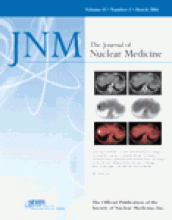TO THE EDITOR:
The recent paper in the Journal of Nuclear Medicine by Mochizuki et al. (1), concerning the targeting of 99mTc-annexin V to apoptotic cells in a tumor xenograft, is interesting with respect to the role of the spleen in the normal biodistribution of the radiotracer. Thus, apart from the kidneys, which are expected to appear prominent on images as a result of nonspecific tubular reabsorption of filtered tracer, the spleen stands out as the major normal-organ target, accumulating 30 times more radiotracer, after correction for weight, than the xenograft. In line with this, although not as impressive, the human spleen also accumulates annexin V and is second only to the renal tract with respect to the absorbed dose after administration of 99mTc-annexin V (2,3).
It would not be surprising for the spleen to accumulate large amounts of 99mTc-annexin V since it is a powerhouse of physiologic destruction of circulating granulocytes. These cells circulate in humans with a half-life (t1/2) of about 7 h, which translates to a mean intravascular lifespan of only about 10 h. In other words, the circulating granulocyte population is replaced twice a day. Until the development of reliable methods of cell labeling with 111In (reliable in the sense that granulocyte activation is avoided (4)), the view was generally held that granulocytes left the circulation by migrating into the extravascular space throughout the body, serving the role of scavenging for bacteria and maintaining a sterile internal milieu. The introduction of 111In-granulocytes for kinetic studies forced this view to be changed. Thus, it was shown that in the absence of inflammation, 100% of the administered activity after injection of 111In-granulocytes could be accounted for in the reticuloendothelial system at 24 h, when all the labeled cells had been cleared from the blood (5). Parallel nonimaging studies reinforced this finding by showing that no significant amounts of 111In could be recovered from urine, saliva, or feces of healthy subjects (5). Quantitative whole-body imaging studies identified the spleen as a major site of granulocyte destruction, with around a third of administered 111In present in the organ at 24 h and the rest in liver and bone marrow (5).
For a relatively small organ, these figures are remarkable—perhaps not at first sight but clearly so after consideration of some straightforward quantitative physiology. Thus, in a healthy subject, the blood concentration of granulocytes is about 5 × 109/L. Total blood volume is 5 L, and the circulating granulocyte pool is about 50% of the total blood granulocyte pool (5–7), indicating that there are 5 × 1010 granulocytes in the total blood granulocyte pool. With a circulating t1/2 of 7 h, the total hourly rate of destruction is 5 × 109 (i.e., [5 × 1010] × [0.693/7]). If the spleen destroys a third of these, then its absolute rate of destruction is about 3 × 107/min. Because splenic blood flow is about 200 mL/min, 3 × 107/min is 3% of the incoming cells (0.2 × 5 × 109/min), allowing the prediction of a constant arteriovenous granulocyte concentration gradient across the spleen of 3%! We are not aware that this has ever been confirmed experimentally.
How does this rate of destruction compare with the accumulation rate of granulocytes in an abscess? Interestingly, the t1/2 of granulocytes in the circulation is not significantly reduced in acute inflammation (7), although the peripheral granulocyte count is raised. Nevertheless, a collection even half the size of the spleen would be considered a large abscess, which would be expected to be easily seen with 99mTc-annexin if indeed this radiotracer is effective for the imaging of apoptosis associated with inflammation.
A further interesting caveat is that although there appears to be general agreement that granulocytes die by apoptosis (i.e., programmed cell death), both in vitro and in vivo at sites of inflammation (8,9), circulating apoptotic granulocytes are rarely, if ever, seen and the blood survival profile of radiolabeled granulocytes in vivo is exponential (5–7). Therefore, unlike the case with red cells and platelets, both of which give survival profiles that are linear and thereby consistent with an age-related destruction mechanism, granulocytes have a survival profile that is consistent with random extraction and destruction and inconsistent with age-dependent death and removal.
Is apoptosis therefore relevant to physiologic granulocyte destruction, or is it a phenomenon restricted to inflammation or even just to the laboratory bench? If splenic destruction is anything to go by, these rodent data, and to a lesser extent the human data, suggest that apoptosis is important physiologically. If physiologic splenic granulocyte destruction is based on apoptosis, we need to find mechanisms in vivo for converting it from an age-dependent process into what appears to be a random one. The obvious starting point is the spleen, within which granulocytes pool with an intravascular transit time that has a mean value of about 10 min but is randomly distributed (10).







